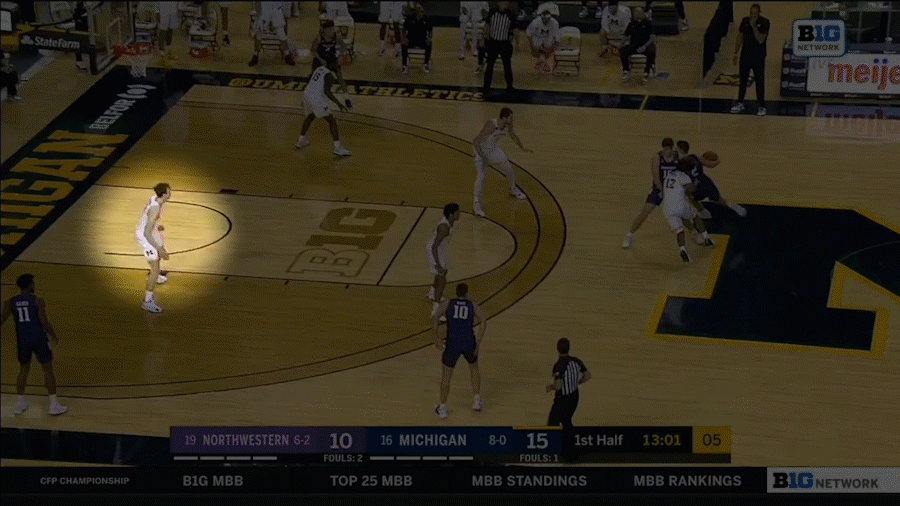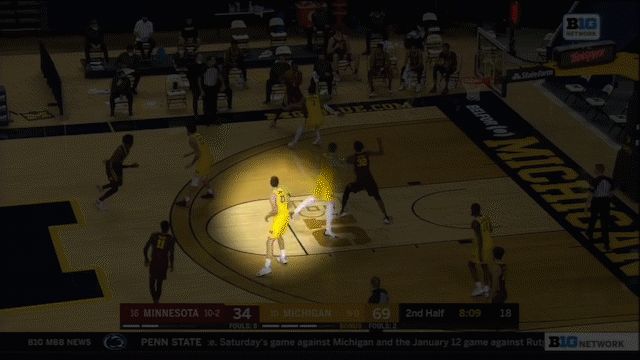All Aboard The Franz Wagner Bandwagon
The best NBA prospect in the Big Ten is an afterthought on his own team. Why Franz Wagner is the key to Michigan's success.
I’m old enough to remember the day that Juwan Howard was hired by Michigan.
I’m also old enough to remember how many people that said hiring an NBA star that never coached in college will never work.
It may feel like he’s been there for years at this point — 2020 was a decade, after all — but the truth is that it was less than 20 months ago that the Wolverines lost John Beilein to Cleveland. A week after Beilein left, Warde Manuel pulled Howard off of Eric Spoelstra’s bench and brought him back to Ann Arbor, and less than two years into the project, Howard’s tenure is an unequivocal success so far.
Year 1 was, for the most part, fine.
One could argue, after Michigan started the season 7-0 with wins over Creighton and Gonzaga and shot up to the top five nationally, that finishing 19-12 overall and 10-10 in the Big Ten was mildly disappointing. But it’s hard to scoff at a coach getting a program into the top 20 on KenPom in his first season running a program despite losing three players to the professional ranks with eligibility remaining.
Put another way, a 19-12 season and a 10-10 mark in the Big Ten is only disappointing without the context that the Big Ten was insanely strong, that a hot start to the season set expectations higher than they realistically should have been.
This season, however, has quieted every remaining doubter.
Michigan is 11-0 through the season’s first two months. They are 6-0 in the Big Ten. They’ve won their last three games by at least 19 points, and all three came against ranked opponents. That’s the first time that’s happened.
Perhaps what’s been the most impressive part about this season is that it comes a year after Michigan’s two most important players graduated. Zavier Simpson was Michigan’s coach on the floor, a guy tasked with spearheading the defense and making decision after decision offensively. Jon Teske was the anchor, a 7-footer that could hit threes, scores on the block, protect the rim and move his feet in ball-screens. Replacing the bookends of a lineup is never easy to do.
And Howard did it.
He landed five-star freshman Hunter Dickinson to replace Teske. Dickinson has morphed into an All-American candidate simply because he embraces his size. He’s a big man that knows he’s a big man and loves doing big man things. His DGAF attitude towards the minions that can’t match his size has been a pleasure to watch.
Howard also tapped into the transfer market, landing a grad transfer from Columbia — Mike Smith — to run the point while also bringing in a capable 3-and-D wing from Wake Forest — Chaundee Brown — to be a shot of energy and athleticism off his bench. Brown, I should mention, is shooting 39 percent from three as well.
He’s also managed to build a core of upperclassmen that are finally embracing their time to shine. Isaiah Livers would have had a shot to play in the NBA had he opted to leave school last season. He’s back, as is Eli Brooks, who likely doesn’t have the NBA in his future but has nonetheless been a pleasant surprise in an expanded role.
But the key to this year’s Michigan team, the most important player on this year’s roster, is the guy that most fans will know as, simply, “Mo’s brother.”
Today’s post is free and available to all. For more content like this, please consider becoming a subscriber for $7 a month or $70 for the year. Your support helps keep The Rebound independent and ad-free.
Franz Wagner is not the biggest player on this Michigan roster. He’s not the fastest, or the most athletic, or the best leaper. He’s not the best passer. He’s not the best shooter. The only statistical category that he leads the team in is steals. Michigan has a nine man rotation. The only player in the rotation with a lower usage rate is Eli Brooks.
And I’m still willing to plant a flag on Franz Island, to captain the Franz Wagner Hype Train.
Are you ready for it?
Franz Wagner is the best NBA prospect in the Big Ten this season. He’s a player that absolutely must be evaluated by any team drafting in the back-end of the lottery. He may just be the most improved player in the country, and to be frank, it’s something that we all should have seen coming.
As a freshman, Wagner, who stands 6-foot-9, was listed at 205 pounds. As a sophomore, he’s listed at 220 pounds. That’s a by-product of spending lockdown with his brother Mo, a former Michigan All-American and current Washington Wizard, lifting weights and making #gains. He’s faster. He’s bouncier. Most importantly, he’s stronger; he’s not getting tossed around in the paint, or blown by on the perimeter.
It’s also important to note that Wagner is only scratching the surface on these physical improvements.
Chew on this for a second, because it may be my favorite stat in college basketball this season:
Wagner arrived at Michigan as a 17-year old in the summer of 2018. He turned 19 on August 8th, making him nine months younger than Hunter Dickinson, who is a 20-year old freshman. He’s six weeks younger than Evan Mobley. He’s six weeks older than Cade Cunningham.
And he’s averaging 12.5 points, 7.1 boards, 3.0 assists, 1.3 steals and 1.3 blocks while shooting 36.1 percent from three. No high-major player has hit those thresholds since 1992. Only eight players have come close, among them Anfernee Hardaway, David West, Lamar Odomm Tim Duncan (who did it twice), Grant Williams and Earl Clark.
Having said that, stats are nothing but numbers on paper. Arbitrary thresholds are fun and I love them more than anyone, but again, they’re just numbers, meaningless without context.
The numbers don’t matter much if the tape doesn’t back it up.
So let’s go to the tape.
And more than anything else, what the tape shows is that Wagner is just an elite positional and team defender. He does not make mistakes on that end of the floor. For a kid that’s 19 he has an exceptional defensive IQ and awareness of the players on the floor around him.
Below you’ll find an example of what I mean. Eli Brooks gets beaten baseline. Wagner is in position to help, leaves his man and goes vertical, forcing Marcus Carr to give the ball up. Eventually the ball ends up in the hands of Jamal Mashburn Jr. As he comes off of a ball-screen, Wagner is in position to tag the roller before using his length to disrupt the pass to the corner and closing out long to run Gabe Kalscheur off of the three-point line, forcing a turnover.
All of that happened in one possession.
And none of it is all that exciting.
Nothing shows up in Wagner’s stat line. If you don’t know what you’re looking for, you probably won’t even notice. But it’s the reason Michigan was able to get the stop on this possession, and after studying Michigan film this week, I have an entire notebook page filled with examples of Wagner executing like this on the defensive end of the floor.
The reason this is so important in the context of this Michigan team doubles as a reason why I’m so bullish on Wagner as a pro.
As an on-ball defender, Wagner is good. He knows how to sit in a stance, he can move his feet pretty well for someone his size and he has an understanding for how to use his length to make up for the fact that he’s not a super explosive athlete. If he gets switched onto a point guard, he can hold his own. Same thing if he gets switched onto a big. Howard used him on both Pete Nance and Miller Kopp against Northwestern. He spent some time on D’Mitrik Trice against Wisconsin.
The value is in the versatility as opposed to really being able to put the clamps on one possession; switchability is the name of the game at the next level.
For the Wolverines, however, what it means is that since Wagner is not their best on-ball defender, he’s often tasked with guarding off-the-ball.
Why is that important?
As good as Dickinson is on the offensive end of the floor, he’s not exactly the most fleet-a-foot five. It’s why, despite his production and his efficiency, he’s not considered to be a lock first round pick in June. But despite that, Michigan is still defending ball-screens at an impressive clip.
Why?
Because Wagner is capable of things like this:
He’s the glue that holds it all together defensively, and that’s precisely the role that he’ll be asked to play at the next level.
I fully believe that he’ll be really good in that role.
As weird as it may sound for a Wagner, the question mark with Franz is on the offensive end of the floor.
More specifically, the question is whether or not the jumper is real.
On the season, Wagner is shooting 36.1 percent from three. For his collegiate career, he’s shooting just 32 percent on more than 160 attempts. But there is also some content to take into account here. Wagner missed time at the start of his freshman season with a hand injury. Once he finally started getting back into a rhythm, he got hit with a nasty case of the flu. He didn’t really get to 100 percent until the final seven games of the season, a stretch where he averaged 15.8 points and shot 13-for-34 (38%) from three.
If you buy Wagner as someone that can shoot in the upper-30s from three — which I do — that’s the differentiator.
Because the feel is there offensively. He can do a little bit of everything on that end; again, his strength is his versatility. He can handle the ball well enough that Howard allows him to grab-and-go at times. He can operate in ball-screens as a scorer and a creator. He can run off of screens to score. He has long strides and can attack a closeout.
He’s also not a ball-stopper, which can be a good thing or a bad thing. Wagner is not all that assertive. He’s opportunistic and he can get hot, but he’s also perfectly fine with being a ball-mover that, as the cliche goes, allows the game to come to him.
But it works with this group.
The truth is that Michigan’s offense is built around the threat of Dickinson. It actually reminds me a bit of the 2018 Purdue team that won 30 games based on Isaac Haas post-ups and four sharpshooters around him. Michigan’s top five perimeter weapons combine to shoot 39.4 percent from three. That’s why Dickinson is so ruthlessly efficient. You can’t double-team him, but you have to double-team him.
In that comparison, Wagner is Dakota Mathias, a 6-foot-4 guard that was a 23-year old senior that season and scored 14 points for the 76ers in a game last week.
Wagner is 6-foot-10.
He’s 19 years old.
And he can do all of this:






I just haven’t been all THAT impressed with him. I agree with Matt. He was atrocious against Minnesota yesterday. He just seems to show up occasionally.
Way to much hype after last season and way too inconsistent this season. He was a nightmare against Minnesota on Saturday.